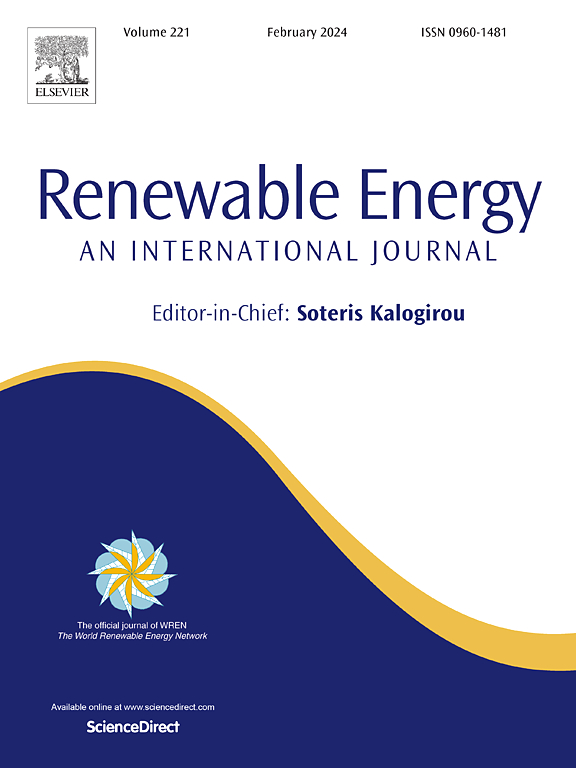Enhanced photocatalysis efficiency of flower-like Ni/ZnIn2S4 coupling with supplying-hydrogen alcohols to catalyze lignin β-O-4 models into aromatic monomers
IF 9
1区 工程技术
Q1 ENERGY & FUELS
引用次数: 0
Abstract
Owing to the fussy depolymerization conditions and the limited photocatalytic efficiency, enhancing lignin valorization into aromatic monomers still remains challenging. Herein, the combination of photocatalyst optimization and solvent effect was reported to efficiently scissor the Cβ-O bond in lignin β-O-4 model (2-phenoxy-1-phenylethanol, PP-ol) into ketones and phenols. The doped Ni species in ZnIn2S4 acting as electron-trapping sites inhibited the recombination of photogenerated carriers, leading to an enhanced photo-quantum efficiency. During the generation of 2-phenoxy-1-acetophenone (PP-one), the key intermediate of ·Cα radical was formed, which significantly decreased the dissociation energy of Cβ-O bond to 66.9 kJ/mol. The competition between hydrogenolysis and dehydrogenation for these ·Cα radicals determined the products distribution of PP-one, phenol and acetophenone. Solvent effect played an important role in the above process. The concentration of atomic hydrogen species was highly increased assisted with EtOH as supplying-hydrogen agent, promoting the hydrogenolysis of Cβ-O bonds in ·Cα radicals to aromatic monomers rather than their further dehydrogenation to PP-one. Based on the structure characterization, trapping and control experiments, the photocatalytic mechanism for lignin models depolymerization was proposed. Current work provides a simple and universal method in combination with photocatalyst optimization and solvent effect to accomplish the lignin valorization under solar drive.
花状Ni/ZnIn2S4与供氢醇偶联催化木质素β-O-4模型生成芳香单体的光催化效率提高
由于解聚条件复杂,光催化效率有限,使木质素活化成芳香单体仍然是一个挑战。本文报道了光催化剂优化和溶剂效应的结合,有效地将木质素β-O-4模型中的c - β- o键(2-苯氧基-1-苯乙醇,PP-ol)剪切成酮类和酚类。ZnIn2S4中掺杂的Ni作为电子捕获位抑制了光生载流子的重组,从而提高了光量子效率。在生成2-苯氧基-1-苯乙酮(PP-one)的过程中,形成了·Cα自由基的关键中间体,使Cβ-O键的解离能显著降低至66.9 kJ/mol。这些·Cα自由基在氢解和脱氢过程中的竞争决定了pp - 1、苯酚和苯乙酮的产物分布。溶剂效应在上述过程中起着重要作用。在乙氧乙酸的辅助下,原子氢的浓度大大增加,促进了·Cα自由基中Cβ-O键的氢解生成芳香单体,而不是进一步脱氢生成pp - 1。基于结构表征、捕获和控制实验,提出了木质素模型解聚的光催化机理。目前的工作提供了一种简单而通用的方法,结合光催化剂优化和溶剂效应来实现木质素在太阳能驱动下的增值。
本文章由计算机程序翻译,如有差异,请以英文原文为准。
求助全文
约1分钟内获得全文
求助全文
来源期刊

Renewable Energy
工程技术-能源与燃料
CiteScore
18.40
自引率
9.20%
发文量
1955
审稿时长
6.6 months
期刊介绍:
Renewable Energy journal is dedicated to advancing knowledge and disseminating insights on various topics and technologies within renewable energy systems and components. Our mission is to support researchers, engineers, economists, manufacturers, NGOs, associations, and societies in staying updated on new developments in their respective fields and applying alternative energy solutions to current practices.
As an international, multidisciplinary journal in renewable energy engineering and research, we strive to be a premier peer-reviewed platform and a trusted source of original research and reviews in the field of renewable energy. Join us in our endeavor to drive innovation and progress in sustainable energy solutions.
 求助内容:
求助内容: 应助结果提醒方式:
应助结果提醒方式:


